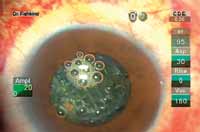Article
Femtosecond laser reduces phaco power
A proprietary femtosecond laser system can create a variety of fragmentation patterns, including cubes, spheres, or a combination, by which the crystalline lens can be fragmented using little or no phaco energy in the eye.


The primary endpoints were the reductions in power as measured by cumulative dissipated energy with a proprietary phacoemulsification system (Infiniti, Alcon Laboratories), and surgeon feedback on what was considered the best algorithm, said Dr. Fishkind, clinical professor of ophthalmology, University of Utah, Salt Lake City, and in private practice in Tucson, AZ.
Dr. Fishkind explained that one algorithm creates cubes of any size and another creates a shape resembling "french fries," in that the shape looks like cubes on the surface, but the effect goes below the surface of the nucleus. A third algorithm creates spheres to break up the nuclear material.
"When the third algorithm is used and the spheres created, the second instrument can be run over the nucleus and endonucleus to break up the spherical subparticles," he said. "Low energy or aspiration then can be used to remove the subparticles."
Softening nuclear material
Dr. Fishkind also demonstrated how the "french fry" algorithm works to remove a grade 3 to 4+ nucleus.
"The amplitudes were very low despite the cataract density," he said. "The laser seems to be very efficient at softening the nuclear material."
The spherical algorithm seemed to have the greatest reductions in power with all grades of nuclear hardness.
"Algorithm 3 lowered the time and energy to below 1," he said.
When surgeons were questioned regarding the hydrodelineation and easy propagation of the chops, algorithm 3 again outranked the other algorithms in all cases.

FYI
William J. Fishkind, MDE-mail: wfishkind@earthlink.net
Dr. Fishkind has a financial interest in this technology.
Newsletter
Don’t miss out—get Ophthalmology Times updates on the latest clinical advancements and expert interviews, straight to your inbox.




